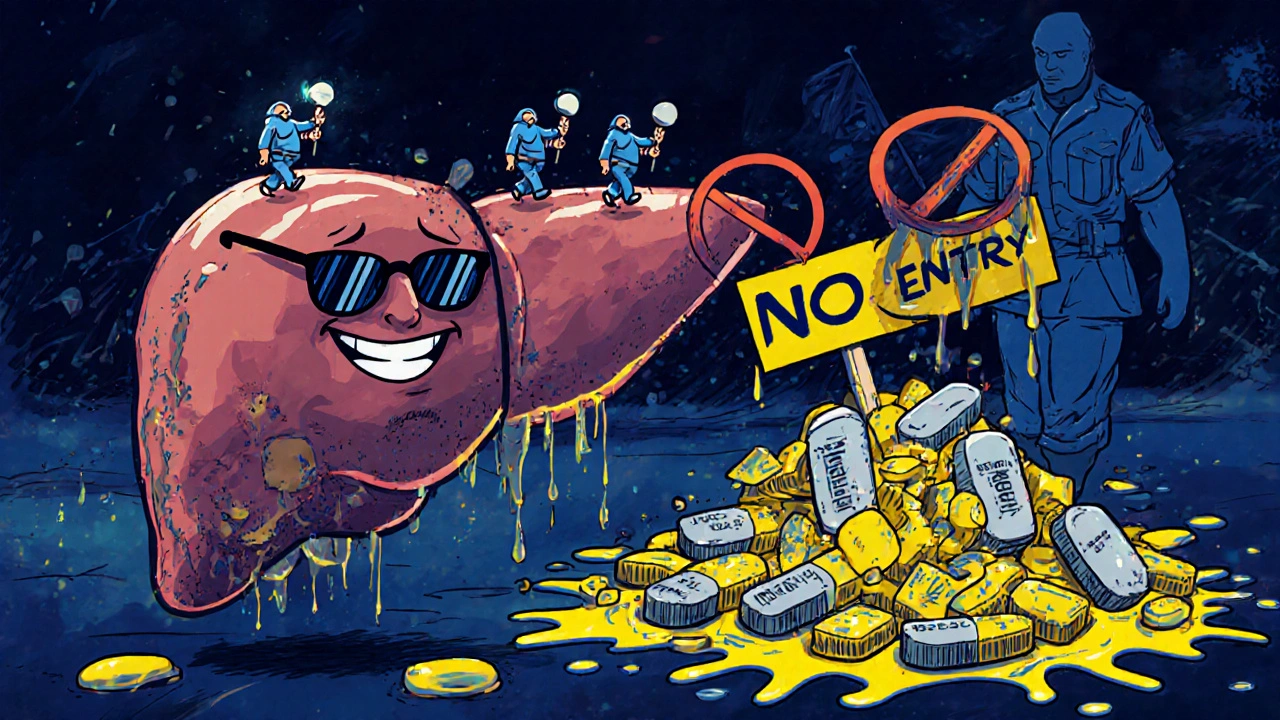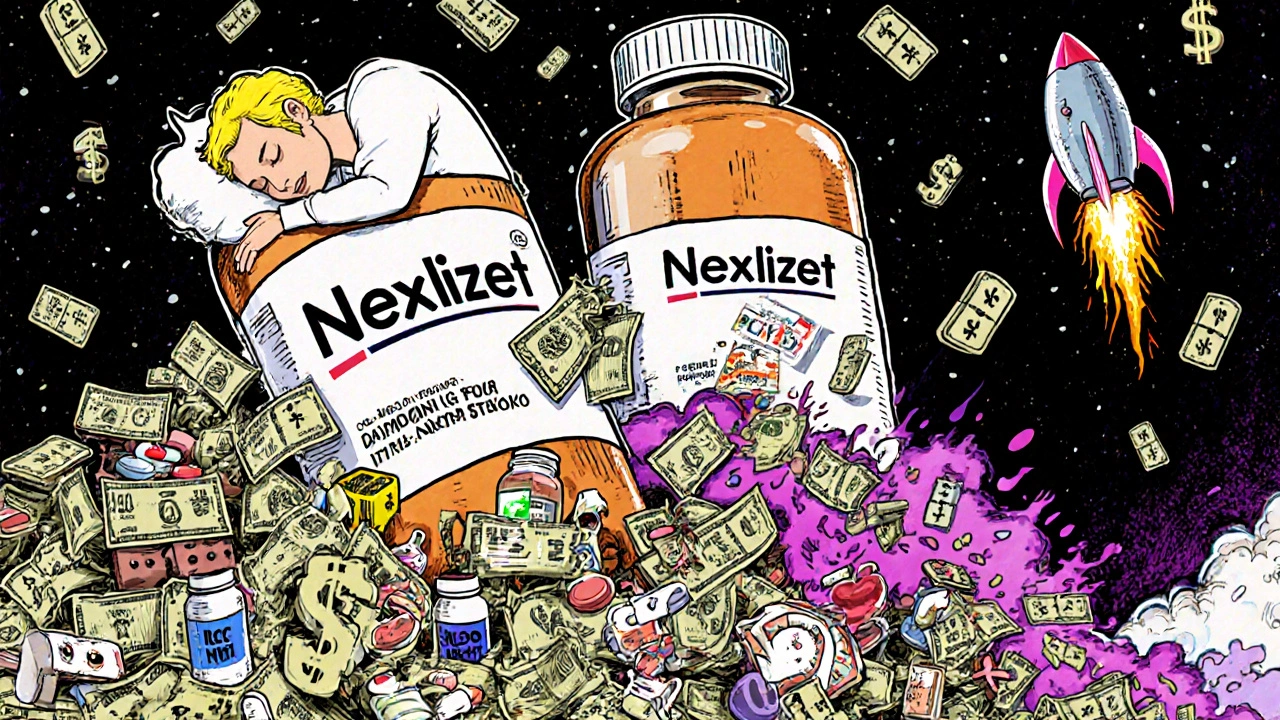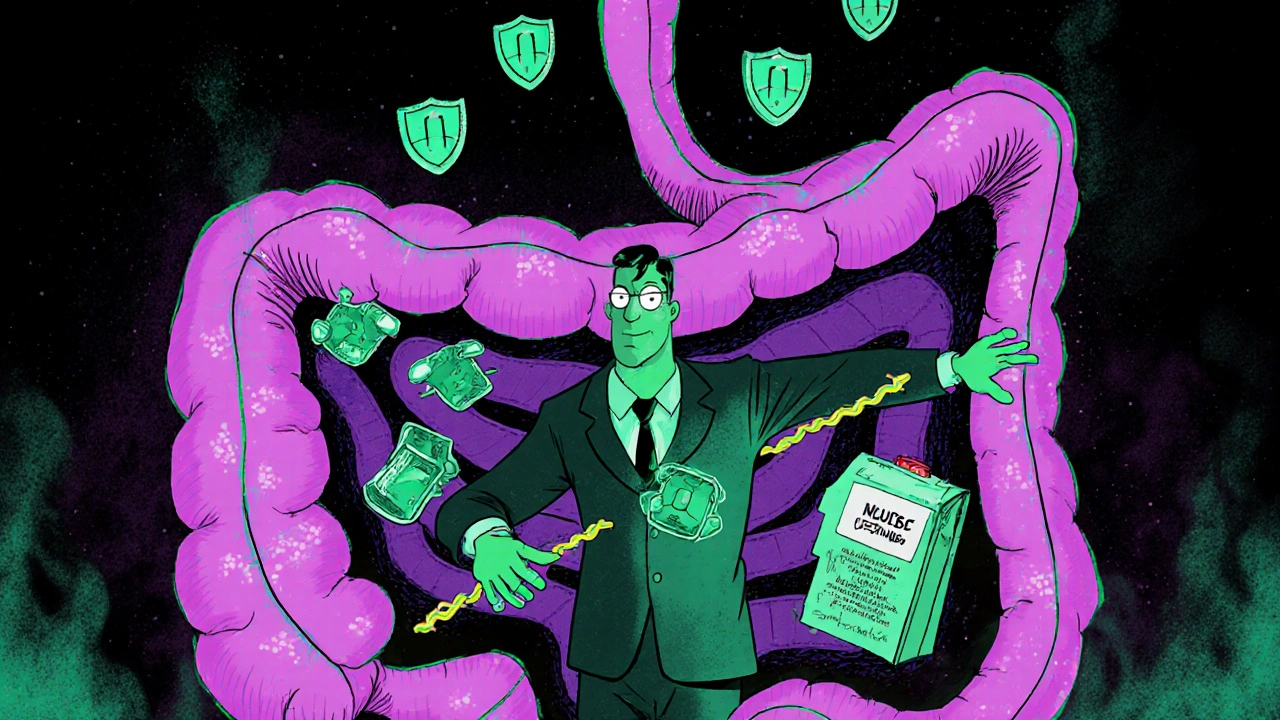Cholesterol Medication Effectiveness Calculator
Enter your current LDL cholesterol level and insurance status to see how much reduction you can expect from alternative medications.
Your Estimated LDL Reduction
Ezetimibe (Zetia)
Lowers LDL by 15-22%
$100+/month without insurance
Bempedoic Acid (Nexletol)
Lowers LDL by 17-23%
$700+/month without insurance
Nexlizet (Combo)
Lowers LDL by 35-40%
Recommended Option
When statins don’t work for you, what do you do? For millions of people, muscle pain, fatigue, or other side effects make statins impossible to keep taking. That’s where ezetimibe and bempedoic acid come in. These aren’t flashy new drugs-they’re practical, proven options for people who need to lower their cholesterol but can’t tolerate statins. And unlike some expensive injectables, both are pills you take once a day.
How Ezetimibe Works (And Why It’s Still Relevant)
Ezetimibe, sold under the brand name Zetia, has been around since 2002. It doesn’t touch your liver like statins do. Instead, it blocks cholesterol absorption in your small intestine. Think of it like a bouncer at the door of your gut-only letting a fraction of dietary cholesterol pass through.
As a standalone pill, ezetimibe lowers LDL (bad) cholesterol by about 15-22%. That’s not as much as a statin, which can knock off 30-55%. But here’s the kicker: when you add ezetimibe to a low-dose statin, you get an extra 18-25% drop. That’s why many doctors still prescribe it even when statins are working-just not enough.
The real win for ezetimibe? Cost. Generic versions cost as little as $4 a month through Medicare Part D. That’s less than a cup of coffee a day. No wonder it’s still one of the most prescribed cholesterol meds in the U.S., with over 12 million prescriptions filled each year.
Bempedoic Acid: The New Kid on the Block
Bempedoic acid, sold as Nexletol, got FDA approval in 2020. It’s different from ezetimibe-and from statins too. While statins block HMG-CoA reductase (an enzyme in the liver), bempedoic acid hits an earlier step: ATP citrate lyase. That’s important because this enzyme isn’t active in muscle tissue. Only in the liver.
That’s why muscle pain, the #1 reason people quit statins, rarely happens with bempedoic acid. In the CLEAR Outcomes trial, only 5.1% of people on bempedoic acid reported muscle issues-almost the same as placebo. Compare that to statins, where up to 29% of patients can’t stick with them because of muscle pain.
As a single pill, bempedoic acid lowers LDL by 17-23%. That’s solid. But here’s what makes it stand out: it actually reduces heart attacks, strokes, and other major heart events. The CLEAR Outcomes trial followed nearly 14,000 high-risk patients who couldn’t take statins. After about 3.5 years, those on bempedoic acid had a 13% lower risk of major heart problems than those on placebo.
That’s huge. It means bempedoic acid isn’t just a lab number fix-it’s a real shield against heart disease.
The Combo: Nexlizet (Bempedoic Acid + Ezetimibe)
In 2024, the FDA approved a combo pill called Nexlizet: 180 mg of bempedoic acid and 10 mg of ezetimibe in one tablet. It’s designed for people who need more than what either drug can do alone.
This combo drops LDL by 35-40%. That’s close to what moderate-intensity statins achieve. And because it’s one pill, adherence improves. No more juggling two bottles. No more forgetting which one to take when.
It’s not perfect. The cost? Around $231 a month with a GoodRx coupon. Without insurance, it’s over $700. That’s why many patients delay starting it-even if their doctor recommends it.

How Do They Compare to Statins and PCSK9 Inhibitors?
Let’s put this in perspective.
High-intensity statins like atorvastatin 40-80 mg or rosuvastatin 20-40 mg can slash LDL by 50-55%. That’s the gold standard. Statins also have 15 years of real-world data showing they cut heart attacks and deaths. Generic atorvastatin costs pennies a day.
PCSK9 inhibitors-injectables like Repatha and Praluent-drop LDL by 50-60%. But they cost $14,000 a year. Most insurers require you to fail statins and oral meds before approving them.
Ezetimibe and bempedoic acid sit in the middle. They’re not as strong as statins, but they’re much cheaper than injectables. And they’re oral. That matters. A lot.
Who Should Take These Drugs?
Not everyone needs them. These are for specific groups:
- People with confirmed statin intolerance-muscle pain, cramps, or weakness that goes away when they stop statins
- People who can’t reach their LDL goal even on the highest tolerated statin dose
- People with a history of heart disease or diabetes who need extra LDL lowering
Doctors don’t jump straight to these. First, they try different statins at lower doses. Sometimes, switching from atorvastatin to pravastatin or rosuvastatin helps. If that fails, then ezetimibe or bempedoic acid enter the picture.
And here’s something most patients don’t know: you need to confirm statin intolerance properly. That means trying at least two different statins over 3-6 months-not just quitting after one bad experience.
Side Effects and Warnings
Ezetimibe is one of the safest cholesterol drugs out there. Common side effects? Mild stuff: headache, stomach upset. Rarely, liver enzymes rise-but not enough to stop the drug.
Bempedoic acid is also well tolerated, but there are red flags:
- Increased risk of tendon rupture (0.5% in trials). This is rare, but real. If you feel sudden pain in your Achilles or shoulder tendon, stop and call your doctor.
- Can raise uric acid levels, which may trigger gout in susceptible people.
- Shouldn’t be used with high-dose simvastatin (over 20 mg) or pravastatin (over 40 mg). It can make those statins too strong.
- Not recommended if your kidney function is severely impaired (eGFR below 30).
Real-world data from PatientsLikeMe shows joint pain is reported by 12.3% of users-higher than the 2.1% in clinical trials. That’s something to watch for.

What Do Real Patients Say?
On Reddit’s r/Cholesterol, one user wrote: “Switched from atorvastatin to bempedoic acid. No muscle pain. LDL dropped from 142 to 101. Life changed.”
Another said: “Ezetimibe only dropped my LDL by 18 points. Barely worth the co-pay.”
GoodRx reviews for Nexletol average 3.7 out of 5. The most common positive: “No muscle pain.” The most common complaint: “Too expensive.”
Ezetimibe scores higher-7.1 out of 10 on PatientsLikeMe. Why? Price. Simplicity. Proven track record.
Monitoring and Follow-Up
Starting either drug? You’ll need a blood test before and again in 4-12 weeks. Your doctor wants to see:
- A 10-15% drop in LDL with ezetimibe
- A 15-20% drop with bempedoic acid
If you’re not hitting those numbers, your doctor may add the other drug or consider a PCSK9 inhibitor.
Also, check your liver enzymes and kidney function yearly. Bempedoic acid is processed by the liver, so if you have fatty liver disease or drink heavily, your doctor will monitor you closer.
Future Outlook
The CLEAR CardioTrack trial, expected to finish in late 2025, is using ultrasound to see if bempedoic acid actually shrinks plaque in arteries. Early signs suggest it does.
Market analysts predict bempedoic acid could capture 25-30% of the non-statin market by 2027. Ezetimibe’s share will likely drop as more people switch to combos or newer drugs.
But here’s the bottom line: for now, ezetimibe and bempedoic acid are the most practical alternatives to statins. They’re pills. They work. And for people who can’t take statins, they’re life-changing.
They’re not perfect. But they’re real. And they’re here to stay.
Can I take ezetimibe or bempedoic acid instead of a statin?
Yes-if you can’t tolerate statins due to muscle pain or other side effects. But statins are still the first choice because they lower cholesterol more and have stronger proof of preventing heart attacks. These drugs are second-line options, not replacements.
Which is better: ezetimibe or bempedoic acid?
It depends. If cost is your main concern, ezetimibe wins-it’s cheap and safe. If you need stronger LDL lowering and have a history of heart disease, bempedoic acid is better because it’s been proven to reduce heart attacks. Many people end up taking both together as Nexlizet.
Does bempedoic acid cause muscle pain like statins?
No-rarely. Bempedoic acid is designed to activate only in the liver, not in muscle tissue. In clinical trials, muscle pain rates were almost the same as placebo. That’s why it’s the top choice for statin-intolerant patients.
How long does it take to see results?
You’ll usually see LDL changes within 4-6 weeks. Your doctor will order a lipid panel around 8-12 weeks to check if the dose is working. Don’t stop the medication if you don’t see immediate results-it’s a long-term therapy.
Are there any foods or supplements I should avoid?
No major food interactions. But avoid high-dose niacin or fibrates unless your doctor says it’s safe. Also, grapefruit juice doesn’t affect these drugs like it does with some statins, so you’re fine there.
Is bempedoic acid covered by insurance?
Many insurers require you to try and fail a statin first. Some require prior authorization. Ezetimibe is usually covered with low copays because it’s generic. Bempedoic acid is expensive without insurance-expect to pay over $700 a month without a coupon or assistance program.
If you’ve struggled with statin side effects, you’re not alone. Ezetimibe and bempedoic acid offer real, evidence-backed options. Talk to your doctor about whether one-or both-could work for you.



So ezetimibe is like $4 a month? That’s wild. I wish all meds were this cheap.
I switched to bempedoic acid last year after three failed statin tries-my legs felt like concrete every morning. Within two weeks, the pain vanished. My LDL dropped from 158 to 97. Not magic, but it felt like waking up after years of sleepwalking. And yeah, the price is brutal without insurance, but I got a patient assistance program to cover 80%. If you’re suffering, don’t give up. There’s a middle ground between statins and $14k injections. This stuff works. I’m not some biohacker-I’m just a regular person who needed a break from feeling like a broken car.
my doctor just threw ezetimibe at me like it was a bandaid 😅 i took it for 2 months and my ldl barely budged… like 10 points? i was so disappointed. but then i found out about nexlizet and now i’m on it and honestly? life’s better. no muscle aches, no daily guilt about forgetting pills. just one tab. still expensive as hell though 💸
Why are we even talking about this? If you can’t take statins you’re probably just lazy or eating too much pizza. My grandpa took Lipitor at 80 and ran marathons at 75. Stop looking for easy outs. The system is rigged to sell you expensive pills instead of telling you to eat real food
So bempedoic acid doesn’t hurt muscles but it can rip your tendons? That’s like trading a slow leak for a bomb. 🤡 Also why is this even a thing? Why not just tell people to stop eating donuts? We’ve turned medicine into a video game where you collect pills instead of fixing your life.
Just wanted to say thank you for this post. I’ve been scared to talk to my doctor about statin side effects because I thought I was just being weak. Reading this made me feel seen. I’m on ezetimibe now and it’s not perfect but it’s the first thing that didn’t make me feel like I was being slowly poisoned. Small wins, right?
Bempedoic acid is liver activated. Safe for muscles. Good option. Cost issue real. Ezetimibe still best budget choice.
People these days want magic pills while eating fried chicken and watching Netflix. My village in India we used turmeric and exercise. Now we have billion dollar pharma selling one pill solutions. Bempedoic acid? Sounds like a corporate name for a placebo. Real health is not in a bottle
My mom’s on Nexlizet. She’s 72, diabetic, had a stent two years ago. She was terrified of injections. This pill gave her peace. She checks her levels every 12 weeks and the numbers are stable. She says the only downside is remembering to take it with food. Honestly? That’s the best outcome I’ve seen from a new med in years.
Anyone else notice how the article mentions tendon rupture but no one talks about it? I know a guy who tore his Achilles on bempedoic acid. He didn’t even feel it coming. That’s not rare. That’s a warning sign we’re ignoring. Don’t just trust the clinical trial numbers-real people live with the consequences.
Thank you for the detailed breakdown. I appreciate the balance between efficacy, cost, and safety. As a healthcare provider, I’ve seen too many patients abandon treatment due to cost or fear. This kind of clarity helps guide real conversations. Ezetimibe remains a cornerstone for many. Bempedoic acid is promising, but monitoring is non-negotiable. Let’s not replace one dogma with another.